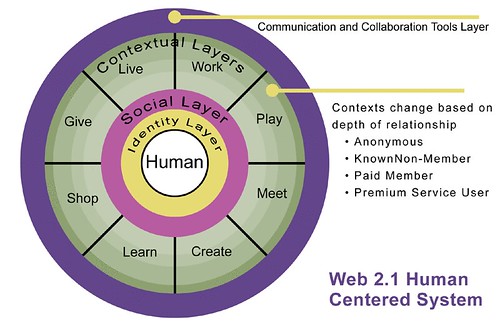The emergence of new technologies continue to change how many of us – as individuals, business folks and our online identities management of our interactions and information is becoming increasingly more complex. Ultimately, online identities can represent people, companies, products and brands. Identity online is becoming more like a house of brands, than a branded house for many of us. The complexity of managing a portfolio of identities/brands is becoming increasingly more challenging as we engage our personal networks, customers and business networks. Context and the complexity of context is making it even more difficult.
Context Defines Identity?
So I was watching The Soup the other day and I was generally amazed at how many of the personalities/identities I actually knew. The problem is I only know of these identities/celebs because of the Soup. I have no other context, except for Anderson Cooper, who wase featured on one of the more entertaining segments in the episode I just got to watch thanks to Tivo. The other thing which has got me to thinking about identity is some work I have been doing with ASC X12 and the context of where the market is, where the organization is and where it needs to go. These two things got me thinking back to how can context of a given set of interactions impact identity or the management of identity.

The Echo Chamber
Context is one of the more interesting challenges of identity and I as a user of many platforms have way too many context sets to manage. I’ve spent a great deal of time trying to streamline my online experience of late, but have been challenged to keep up with the pace of network specific interactions. My initial streamlining was related to getting yet another ID at ping.fm to help keep a consistent pulse across my networks and for that use case it works. The problem with ping.fm is that it is not conversational – you end up with orphaned replies on Facebook, twitter and other social networks.
Leveraging a tool which only speaks AT others rather than listening too is not a good thing for maintaining and developing relationships… With Ping.fm you end up with replies which echo into silence, until 3 or 4 days later when you check in at that given platform. Privacy and conversation are key drivers of the increasing identity crisis folks who are attempting to manage identity online with one way updates just doesn’t solve for.
Do I want my professional network to know the same thing my personal network know? How many networks do I need to update with my the latest picture of my kids?
The 4 P’s of Identity
When thinking about the say 8 accounts I commonly use, the ability to engage AND manage the relationships, responses and outreach can be a daunting task. Beyond the basic administrivia of each account, the challenge of trying to understand how to manage the mix of my activities and platforms continues to grow.
While ping.fm is interesting, it mainly is a broadcast tool, unless there is some well hidden feature I can’t find. As a tool, it only represents the ability to consolidate presence, not the ability to manage platform capabilities, promotion and placement. Identity as a brand or product is essentially what develops in each of the channels you participate in. If each instance of identity becomes a product, that means as platforms change, people migrate and new capabilities are available on a single platform identity/brand equity is diluted and management gets more complex.
So what are the 4 P’s of identity?
- Platform – The holder of the ID account from a technology perspective is commonly the definition of a given platform. Typically platforms have unique account management and network capabilities which are not open, for the most part, for third party management.
- Presence – The capability set typically associated with where you are and what you are doing. Twitter or the Plurk are good examples of platforms which support presence.
- Placement – Group membership on a platform is one way to look at placement, but as are the ways which you allow to be contacted or how you can be engaged in context of group or platform. On some platforms you may expose email, others you might constrain to the core messaging option, such as inbox messages or the wall on Facebook.
- Privacy– Each platform, identity and group has privacy management attributes and rules which need to be managed. The management of privacy is uniquely related to the relationship you have in context of a platform and group.

Why is identity such a challenge online?
If you share content online, it doesn’t go away. However, if you share something at a dinner table it might be moved from memory, but it definitely isn’t a broadcast or a sustaining reality. Just imagine if that incredibly stupid thing you said after your 3rd bottle of Silver Oak lived on forever? It is the broadcast and permanency of content/interactions which make managing context and identity a far more complex thing. As an example, my offline identity is pretty much Jon and maybe a couple of nicknames, each with their own context, but mainly that context isn’t necessarily shared, even if the moniker is used more widely. I recently got a new nickname, Echo, while a seemingly fun name and definitely has an affinity to who I am that identity has no context outside of 3 people, the adoption is getting wider than expected. While Echo usage is growing, the context isn’t being shared. On some level the visibility of context is greater and can be shared, not so much in the real world.
The key challenges of managing the 4 P’s of identity are unique to being online and the fragmentation, management and interaction requirements require some type of solution. Technologies to update, integrate and provide security/authorization are out there, but a great deal of work is needed to actually manage, protect and OWN your data. Perhaps interoperability isn’t enough, we need to also support portability to better manage identity.
DataPortability – Connect, Control, Share, Remix from Smashcut on Vimeo.


